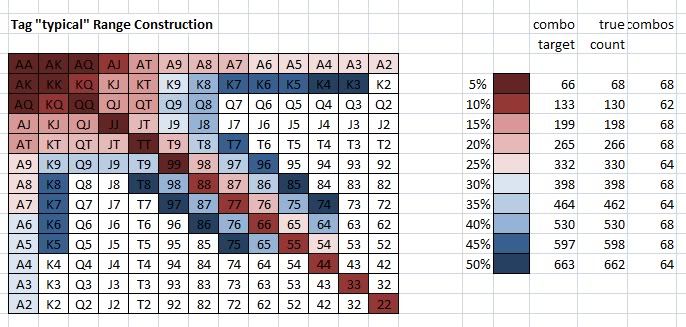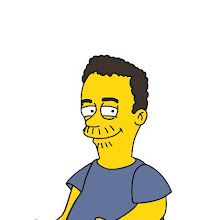My most pressing need in my poker education is working on ranges. I know that a 12/10 player is "tight" and a 35/10 is "loose" and 65/0 is "donkeyfishzomgI'mnotleavingthistable". But what hands are they playing? When a board reads 4 to a straight, can you discount a player having that card because of his stats? Not for sure, of course. But you can do a great deal of deduction if you can get a sense of the types of hands a player is playing.
That has been my project this week - determining realistic hand ranges for someone playing 5% of their hands, 10%, 15%... all the way up to 50%. Someone might say "that's been done already - it's called Pokerstove". But I have some problems with Pokerstove's ranges. Pokerstove determines hand strength based on something called "4-way equity", or the percentage chance that each given hand wins at showdown while up against 3 random hands. That's not how people decide which hands are best to play.
Here's one of the most obvious examples: Pokerstove puts pocket twos at about the 58% mark in hand strength. But everyone plays pocket twos in Texas Holdem (under the right conditions) for their set value. Poor 4-way equity or not, people are playing pocket 2s much more often than Pokerstove rates them.
So I tasked myself with coming up with "real world" ranges. Once perfected, I will memorize them and it will help me make decisions on player's holdings. My current iteration can be seen below. I don't think it's perfect yet, but it represents a good first pass with a second pass of refinements.

Some notes on the groupings I've assigned:
Top 5% is 99+, AK, and AQ. I have alternately seen 77+ and AK. I think both are correct and more a matter of playing style (playing style will always affect hand choice - some players are suckers for flushes and lean towards suited cards, some play and pair for any amount to try and flop a set). I chose AQ over 77 and 88 in my top range as it suits my own personal style more.
Top 10% adds all pairs, as well as KQ (suited and unsuited), and AJs. Here we see how pocket 2s and 3s jump way up from their 4-way equity spot into a place more indicative of how often they are actually played. We always worry about 11/9 nits flopping hidden sets on us - this hand range reflects that.
Top 20% has all 2 broadway cards, a few suited aces, and some suited connectors. Note that no unsuited connectors are found up this high yet.
Knowing things like this can help you put people on hands much easier. I'll give an example - say a tough, aggressive regular opens from middle position and you call on the button with KQs. Your HUD tells you his opening range is about 20% from this position. The flop comes Kh 6c 7h, and he checks. You bet your top pair, and he checkraises you. What hands can you put him on?
This player is capable of semibluff checkraising his draws, but what draws could he have? Hearts for sure. What about 89 for a straight draw? Well, sure, 89 fits in my 20% range if you look at the picture. But only 89 suited. There are only 4 combinations of 89 suited. How about 67 for two pair? Again, he could have 67s according to my range chart, but notice he can't have 6c7c (because the 6 of clubs is on the board), or 6h7h (because the 7 of hearts is on the board). So the only two pair combinations he can have are 6s7s or 6d7d.
Here's a similar exercise - I posted a variation of this hand on the 2+2 forum - it's actually the hand that inspired me to start this range analysis project. I'll leave the answer as a question for you to answer in comments.
You finally get your pocket aces on a table with a guy playing 50/10. His aggression factor is 0.9. He limps (like he always does), and you raise it up to 5 big blinds. He calls (like he always does). You both started with 100 big blinds. The pot is now 11 big blinds.
The flop is 922 rainbow. He checks, you bet your aces for value (8 into 11), and he checkraises you to 25. Do you get the money in here?

2 comments:
Can I add one more detail to your analysis of hand ranges vs. VPIP? For me, I know I'm like a 5 out of the UTG positions, and increasingly opening up my range as my position gets further, culminating in a 30-40 out of the BTN. Same idea for PFR, FWIW.
Range by position is definitely more accurate than overall VPIP/PFR, which is an average of all positions.
It was also pointed out to me that calling ranges are constructed differently than opening ranges -something else to keep in mind.
Post a Comment